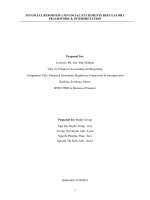informationtechnology assignment 1 unit networking
Bạn đang xem bản rút gọn của tài liệu. Xem và tải ngay bản đầy đủ của tài liệu tại đây (1.64 MB, 55 trang )
<span class="text_page_counter">Trang 1</span><div class="page_container" data-page="1">
<b>BTEC FPT INTERNATIONAL COLLEGE </b>
<b>INFORMATIONTECHNOLOGY </b>
<b>ASSIGNMENT 1 UNIT:NETWORKING</b>
<b> STUDENT : NGUYEN TRINH ANH TUAN CLASS : IT 05102</b>
<b> STUDENT ID : BD00096</b>
<b> SUPERVISOR : TRUONG DANG HIEU </b>
<b>Da Nang, July 2022</b>
1
</div><span class="text_page_counter">Trang 2</span><div class="page_container" data-page="2"><b>ASSIGNMENT 1 FRONT SHEET </b>
<b>(1st submission)</b>
<b>(2nd submission)Student name NGUYEN TRINH ANH </b>
<b>NGUYEN TRINH ANH TUAN</b>
<b>Grading grid </b>
2
</div><span class="text_page_counter">Trang 3</span><div class="page_container" data-page="3">❒
<b>Summative Feedbacks: </b>❒
<b>Resubmission Feedbacks:</b><b>Internal Verifier’s Comments:</b>
<b>Signature & Date:</b>
</div><span class="text_page_counter">Trang 4</span><div class="page_container" data-page="4">1.1...Define network.... 11
1.2 Network type (MAN, WAN,LAN etc.)... 1
WAN is TCP/IP, the bandwidth varies depending on the installation location...13
1.3 Benefit of the network...
1.4 Constraint of the network... 1
1.5 Protocol and Standards... 1
Standard...
Network protocol definition... 1
1.6List some protocols : TCP/IP, HTTP,DNS,ICMP... 17
Internet Protocol (IP)...4
</div><span class="text_page_counter">Trang 5</span><div class="page_container" data-page="5">Hypertext Transfer Protocol (HTTP)... 1
DNS( Domain Name System)...
ICMP( Internet Control Message Protocol)... 19
1.6 List some standard organnizations and standard names...19
II. (P2)Network topology & communication and Bandwidth requirements...20
1.Network topology definition... 2
2.Discuss the Impact of topology... 2
3.Examples of topology with diagrams (Bus, Ring, Star, Tree, Hybrid, Mesh)...21
4.Communication and Bandwidth...25
5.Define Communications In Terms Of Networking...25
Switching principles in a network:...
3.Other commonly used networking devices... 28
4.List server types (web server, mail server, DB Serve, DNS Server, DHCP Server)...32
IV. (P4) Discuss the inter-dependence of workstation hardware with relevant networking software....
1.Explain What Is Meant By Interdependencies...365
</div><span class="text_page_counter">Trang 6</span><div class="page_container" data-page="6">2.Define networking software... 3
3.Discuss and explain the interdepencies of workstation hardware with networking software. Derive an example form your discussion... 3
V. (M1) Compare common networking principles and how protocols enable the effectiveness of networked systems...39
1.Compare LAN, CAN, MAN, WAN...
2.Compare physical topologies and logical topologies...40
3.Compare between OSI reference model and TCP/IP reference model...41
4.Compare TCP between UDP...
Table 2 Compare physical topologies and logical topologies...40
Table 3 Compare between OSI reference model and TCP/IP reference model...41
Table 4 Compare TCP between UDP ………….………38
YFigure1- 1 Network... 11
Figure1- 2 LAN... 12
Figure1- 3 MAN... 136
</div><span class="text_page_counter">Trang 7</span><div class="page_container" data-page="7">Figure1- 5 Networking Benefits... 14
Figure1- 6 Constraint of the network... 15
Figure1- 7 Network protocol denfinition... 15
Figure1- 8 Protocol... 16
Figure1- 9 Standards... 16
Figure1- 10 Netwrok Protocols... 17
Figure1- 11 Internet Protocol... 17
Figure1- 12 HTTP... 18
Figure1- 13 DNS... 18
Figure1- 14 ICMP... 19
Figure1- 15... 20
Figure1- 16 Network topology definition... 20
Figure1- 17 Logical and Physical... 21
Figure1- 34 Access Point... 32
Figure1- 35 List server types... 33
Figure1- 36 Web server... 33
Figure1- 37 Mail server... 34
</div><span class="text_page_counter">Trang 8</span><div class="page_container" data-page="8"><b> LIST OF THE ACRONYM </b>
ACL Access Control List
ADSL Asymmetric Digital Subscriber Line.
ARCNET Attached Resource Computer Network‹
8
</div><span class="text_page_counter">Trang 9</span><div class="page_container" data-page="9">ARP. Address Resolution Protocol
Bit Binary Digit
DHCP. Dynamic Host Configuration Protocol
DHCS Dynamic Host Configuration Server
DNS Domain Name System
INTRODUCTION
Networking piles important role in life. Coming to this report, we will learn about networks, types of networks, network devices,....
9
</div><span class="text_page_counter">Trang 10</span><div class="page_container" data-page="10">building a network and how it works let's learn this article! The report includes the following:
Chapter 1. Examine networking principles and their protocols. (LO1)
1 Discuss the benefits and constraints of different network types and standards. (P1) 2 Network topology & communication and Bandwidth requirements. (P2) CHAPTER 2: Explain networking devices and operations. (LO2)
3 Discuss the operating principles of networking devices and server types. (P3)
4 Discuss the inter-dependence of workstation hardware with relevant networking software. (P4) 5 Compare common networking principles and how protocols enable the effectiveness of networked systems. (M1)
<b>CHAPTER 1: BASIC KNOWLEDGE</b>
10
</div><span class="text_page_counter">Trang 11</span><div class="page_container" data-page="11"><b>LO1: Examine networking principles and their protocols</b>
<b>I. (P1) Discuss the benefits and constraints of different network types and standards.</b>
<b>1. What is network?1.1Define network</b>.
A network is a system of connected elements that work together. Computer networks connect PCs, printers, servers, phones, cameras, and other types of devices. Computer networks connect devices, allow them to exchange data, and facilitate sharing of information and resources.
A network consisting of 2 ormore computers linked
together to share resources (e.g., internal machines and CDs), exchange files and communicate.
</div><span class="text_page_counter">Trang 12</span><div class="page_container" data-page="12">There are three popular networks today:
- Metropolitan Area
Network (MAN Network) - Wide Area Network (WAN Network)
- Local Area Network (LANNetwork)
A network consisting of 2 ormore computers linked
together to share resources (e.g., internal machines and CDs), exchange files and communicate.
Computers can be
connected via wires, phone lines, radio
12
</div><span class="text_page_counter">Trang 13</span><div class="page_container" data-page="13">waves, satellites, or infraredrays.
There are three popular networks today:
- Metropolitan Area
Network (MAN Network) - Wide Area Network (WAN Network)
- Local Area Network (LANNetwo
A network consisting of 2 or more computers linked together to share resources (e.g.. internal machinesand CDs), exchange files and communicate. Computers can be connected via wires, phone lines, radiowaves, satellites, or infrared rays.13
</div><span class="text_page_counter">Trang 14</span><div class="page_container" data-page="14">-Metropolitan Area Network (MAN Network}-Wide Area Network (WAN Network)-Local Area Network (LAN Network)
<b>1.2 Network type (MAN, WAN,LAN etc.)</b>
</div><span class="text_page_counter">Trang 15</span><div class="page_container" data-page="15"><b> Man</b>
MAN (Metropolitan Area Network), also known as urban network, links from many LANs via cables, othertransmission means,... The ability to connect in a large range such as in a town or city , conscious.The MAN network model is often used mainly for organizations and businesses with many branches and departments connected to each other.
Man network is often used for businesses because this model provides many types of services such as connecting lines via voice (voice), data (data), video (image), deploying applications easily. .
- Advantages of MAN network network. The large connection range makes interaction between business parts easy, efficient, low cost, stable transmission speed, information security, simple management.
<i><small>PERFOMED STUDENT: Nguyen Trinh Anh Tuan</small></i>
</div><span class="text_page_counter">Trang 16</span><div class="page_container" data-page="16">WAN (Wide Area Network), also known as wide area network, is a combination of urban networks including MAN and LAN through satellite equipment, optical cables, and power cables.
Wide area network was created to connect on a large scale across the country. The protocol used in the
WAN is TCP/IP, the bandwidth varies depending on the installation location.- Advantages of WAN
Large connectivity, no signal limitation, easy information sharing, data storage. Relative transmission speed varies by region or transmission device.
<b>1.3 Benefit of the network</b>
The Internet is extremely important and brings a lot of benefits to the entire global humanity. The Internet makes information transfer quickly, you can access information on the internet at almost any location on the globe. For the sake of simplicity, to summarize the internet has the following benefits:
High speed.
Can run large online applications thanks to strong bandwidth Cheap and easy to manage
Look up and learn a huge store of information online
Help people do business, sell online, make money and increase jobs
Linking friends and relatives through social networks like Facebook, vegetable garden ZaloSend and receive mail, read online news
Watch movies, listen to music online, play games
<i><small>Figure1- 4 WAN</small></i>
</div><span class="text_page_counter">Trang 17</span><div class="page_container" data-page="17">Using social networking apps…
<i><small>Figure1- 5 Networking Benefits</small></i>
<b>1.4 Constraint of the network </b>
A constraint network represents a mathematical relationship between several variables and is able to compute the value of any one of these variables given the values of all the others.
There are two types of nodes in a constraint network: cells and constraints. Cells represent variables (read-only cells represent constants) and constraints represent primitive mathematical relationships suchas z = x + y and z = x * y. The neighbors of a constraint are the cells that it constrains. The neighbors of a cell are the constraints that constrain it.
<i><small>Figure1- 6 Constraint of the network</small></i>
17
</div><span class="text_page_counter">Trang 18</span><div class="page_container" data-page="18"><b> Network Protocol Definition</b>
2. The protocol is a rule file that defines how to format, transmit, and receive data so that network
3. computers - from servers and routers to endpoints - can
communicate with each other, regardless of any 4. differences in the base
layer, design, or standard facilities.
5.
6. To send and receive data successfully, devices
18
</div><span class="text_page_counter">Trang 19</span><div class="page_container" data-page="19">on both sides of a
communication exchange must accept
7. and follow protocol conventions. Network protocol support can be built into the software, hardware, or
8. both. 9.
10.Standardized network protocols provide networkdevices with a common language. Without them, 11.computers would be
unable to communicate with one another. As a
19
</div><span class="text_page_counter">Trang 20</span><div class="page_container" data-page="20">result, except for networks explicitly
12.designed for a specific architecture, only a few networks can function, and the internet as we know it
13.today would not exist. To communicate with one another, almost all end-users rely on network 14.protocols.
15.The protocol is a rule file that defines how to format, transmit, and receive data so that network
20
</div><span class="text_page_counter">Trang 21</span><div class="page_container" data-page="21">16.computers - from servers and routers to endpoints - can
communicate with each other, regardless of any 17.differences in the base
layer, design, or standard facilities.
18.
19.To send and receive data successfully, deviceson both sides of a
communication exchange must accept
20.and follow protocol conventions. Network protocol support can be
21
</div><span class="text_page_counter">Trang 22</span><div class="page_container" data-page="22">built into the software, hardware, or
21.both. 22.
23.Standardized network protocols provide networkdevices with a common language. Without them, 24.computers would be
unable to communicate with one another. As a result, except for
networks explicitly
25.designed for a specific architecture, only a few networks can function,
22
</div><span class="text_page_counter">Trang 23</span><div class="page_container" data-page="23">and the internet as we know it
26.today would not exist. To communicate with one another, almost all end-users rely on network 27.protocols.
The protocol is a rule file that defines how to format, transmit, and receive data so that network computers - from servers and routers to endpoints - can communicate with each other, regardless of any differences in the base layer, design, or standard facilities. To send and receive data successfully, devices on both sides of a communication exchange must accept and follow protocol conventions. Network protocol support can be built into the software, hardware, or both. Standardized network protocols provide network devices with a common language. Without them, computers would be unable to communicate with one another. As a result, except for networks explicitly designed for a specific architecture, only a few networks can function, and the internet as we know it today would not exist. To communicate with one another, almost all end-users rely on network protocols.
<i><small>Figure1- 7 Network protocol denfinition</small></i>
A protocol is a set of established rules that define how to format, transmit, and receive data so that computer network devices - from servers and routers to endpoints - can communicate with each other. , regardless of the differences in infrastructure, design, or basic standards between them.
23
</div><span class="text_page_counter">Trang 24</span><div class="page_container" data-page="24"><b> Standard</b>
An Internet standard is a specification that is very beneficial to the Internet, has proven to be mature, and is supported by the general public. This title is awarded by the Internet Architecture Council on the recommendation of the Internet. Engineering Task Force (IETF). Standardized procedures were introduced in late 1988. The whole process takes at least a few months and often takes several years. Inmany cases, it is postponed indefinitely. Each Internet standard is either a selected Request for Comments, or a set of multiple RFCs.
<i><small>Figure1- 9 Standards</small></i>
<b> Network protocol definition </b>
A network protocol is a set of rules that a network must follow. Network protocols are formal standards and policies made up of rules, procedures, and formats that define communication between two or moredevices over a network.
24
</div><span class="text_page_counter">Trang 25</span><div class="page_container" data-page="25"><b> 1.6List some protocols : TCP/IP, HTTP,DNS,ICMP</b>
<b>Internet Protocol (IP)</b>
Internet Protocol Suite
The Internet Protocol Suite is a collection of protocols that implement the protocol stack on which the Internet runs. The Internet Protocol Suite is sometimes referred to as the TCP/IP protocol suite. TCP and IP are important protocols in the Internet Protocol Suite - Transmission Control Protocol (TCP) and Internet Protocol (IP). The Internet Protocol Suite is similar to the OSI model, but with some differences. Also, not all layers correspond well.
<i><small>Figure1- 11 Internet Protocol</small></i>
<b> Hypertext Transfer Protocol (HTTP)</b>
HTTP is the data communication platform for the World Wide Web. Hypertext is structured text that useshyperlinks between nodes containing the text. HTTP is an application protocol for distributed and hybrid hypermedia information systems.
HTTP's default port is 80 and 443. Both of these ports are secure.
25
</div><span class="text_page_counter">Trang 26</span><div class="page_container" data-page="26"><b>DNS( Domain Name System)</b>
DNS (Domain Name System) or domain name resolution system, can be explained as a system that helps humans and computers "communicate" with each other more easily (Because of their communication language). We are names and letters, and computers can only understand sequences of numbers!) The system helps to translate domain names (hostnames) into strings of numbers, so that computers can
<b> ICMP( Internet Control Message Protocol)</b>
ICMP stands for Internet Control Message Protocol. Readers can understand simply a protocol of the Internet Protocol packet, also known as the control protocol on the network.
ICMP is used to report errors that occur during the transmission of data packets on the network. Or used to probe and manage the operation of the network.
<i><small> Figure1- 13 DNS</small></i>
</div><span class="text_page_counter">Trang 27</span><div class="page_container" data-page="27"><b>1.6 List some standard organnizations and standard names</b>
ITU - International Telecommunication Union. is an association of national unions, based in Switzerland, founded in 1947, whose members include major government and telecommunications companies.
IEEE: Institute of Electrical and Electronics Engineers): is a non-profit organization, op erating since 1963, with more than 360,000 members (in 2010) including engineers, scientists, students worldwide.IETF: Internet Engineering Task Force) is also an organization that develops standards related to wireless technology
IOS ( International Standard Organization)EIA ( Electronic Industry Association)TIA ( Telecom Industry Association )
<i><small>Figure1- 15 </small></i>
27
</div><span class="text_page_counter">Trang 28</span><div class="page_container" data-page="28">II. (P2)Network topology & communication and Bandwidth requirements
<b>1.Network topology definition</b>
Network topology is the arrangement of the various elements (links, nodes, etc.) of a computer network. Primarily,it is the topological structure of a computer network, and can be described in terms of physics and logic. The physical topology (physical topology) is the arrangement of the various network elements, including equipment storage and cabling settings, while the logical topology (logical topology) specifies how the data flow in the network works. Node distances, physical intersections, transmission rates, and/or signal types can vary between two networks even though their topologies may be identical.
<i><small>Figure1- 16 Network topology definition</small></i>
<b>2.Discuss the Impact of topology </b>
Definition: Physical & Logical Topology.
➢Physical Topology: Physical topology is Physical topology. The interconnected topology of a local area network is physical topology (LAN). Connecting physical devices on a network using cables and cables forms the physical topology.
➢ Logical Topology: Logical Topology is Logical Topology... The logical topology can be automatically maintained and reconfigured by using network devices such as routers and switches. The topology is opposed to physical topology, which refers to the physical interconnection of all network devices.A logical topology is a concept in a network that defines the architecture of the communication mechanism for all nodes in a network. Using network devices such as routers and switches, the logical topology of a network can be automatically maintained and reconfigured. The topology is anti-logical with the physical topology, which refers to the physical interconnection of all devices in the network.
28
</div>








